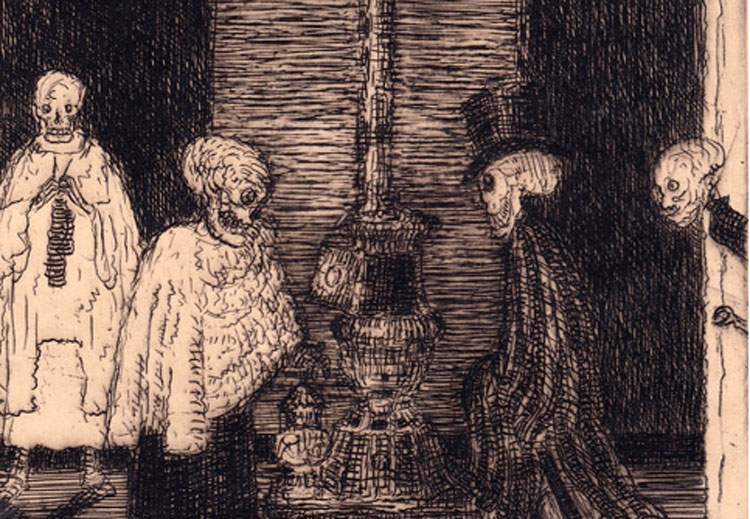Monsters in literature and art, from the 1800s to the present: an exhibition on the theme in Crema
From October 23 to December 12, 2021, the Museo Civico di Crema e del Cremasco is hosting in the Sale Agello the exhibition Monsters. The Dimension of the Beyond, curated by Silvia Scaravaggi. One will have the opportunity to admire 112 works on paper, including graphics, books and illustrations, dedicated to the figures of the monstrous in literature and art, from the 19th century to the present.
The exhibition itinerary runs through two themes, one fantastic-oniric and the other symbolic-esoteric. Starting with Austin Osman Spare’s iconic satyr, we will move through the works of Marcel-Lenoir, Albert Welti, and the Flemish artists James Ensor, Félicien Rops, and Charles Doudelet. Centaurs, mermaids, witches, spirits, and macabre dances populate the images of Italian and foreign engravers such as Raoul Dal Molin Ferenzona, Antonello Moroni, Marcel Roux, Carl Schmidt-Helmbrechts, Giulio Aristide Sartorio, Julius Klinger, František Kobliha, and Francesco Nonni. Among the books on display are Edgar Allan Poe’s Tales of Mystery and Imagination and Goethe’s Faust, both illustrated by Harry Clarke, Annibale Butti’s The Dream Castle illustrated by Alberto Martini, Ralph Nicholas Chubb’s Manhood and Christina Rossetti’s Goblin Market with illustrations by Arthur Rackam, Gustav Meyrink’s Der Golem illustrated by Hugo Steiner-Prag.
In the dimension of dream and fantasy we encounter the wild figures of Maurice Sendak who published Where the Wild Things Are in the 1960s. Alongside this example of contemporary illustration are John Kenn Mortensen’s Post-it Monster and Edward Gorey’s The Doubtful Guest, the drawings of illustrator Nicoletta Ceccoli who tells the story of today through representations of characters from fairy tales or myth, with their corresponding monsters, to Matteo Giuntini’s sign in which layers of meaning and color overlap, and finally to Jacopo Pannocchia with his dark imagery made up of hybridizations between living beings.
The exhibition is closed by three contemporaries with their original drawings and woodcuts: Agostino Arrivabene, Edoardo Fontana and Francesco Parisi, artists who share a common inspiration, that is, they root their research in the most traditional artistic inspiration by drawing a line through Humanism, Primitivism and Symbolism.
The exhibition aims to reflect on the potential of the monster as a means to another dimension and to investigate anethics of overcoming in which a revolution is condensed: the acceptance of otherness, the admission of a flexible and fluctuating reality, neither definitive nor rigid.
The monster in the exhibition is understood as a figure of revelation. Monster is revelation of something that was meant to remain hidden and suddenly reappears: mythology, deities, man’s relationship with nature, supernatural beings, symbols linked not only to rituals but also to crucial historical and social moments, of which they are often revelatory reflections.
Since its origins, the monster has entered the human imagination, in every culture and tradition. The changing forms of the monstrous, accompanied by fascination and awe, poised between light and darkness, populate narratives and illustrations, but no matter how multifaceted the monster may appear, it is always a symbol of access into the unknown. One discovers trends and predilections looking in artistic research from the years between the late eighteenth and early nineteenth centuries: a period in which the focus shifts to what is irrational, unconscious. Scholars, artists, and men of letters are heading toward overcoming the barriers of the senses, and this also happens as a close consequence of an Enlightenment world that had improved the rational view of life but at the same time forced too much in the direction of positivism, inevitably leading intellectuals, artists, and curious souls into the unknown. in the exhibition, the path of knowledge of the monster begins in the late nineteenth century and celebrates that moment of artistic and cultural fervor in which the fascination with the invisible, the irrational, and the unknown is valued.
The exhibition is accompanied by a catalog published by Museo Civico Crema with critical texts by Emanuele Bardazzi, Edoardo Fontana and Silvia Scaravaggi.
For info: www.culturacrema.it
Hours: Saturday and Sunday from 10 a.m. to noon and 2:30 to 5:30 p.m.; Monday through Friday by appointment.
Free admission.
Image: James Ensor, Squelettes voulant se chauffer, detail (1895; etching)
 |
| Monsters in literature and art, from the 1800s to the present: an exhibition on the theme in Crema |
Warning: the translation into English of the original Italian article was created using automatic tools. We undertake to review all articles, but we do not guarantee the total absence of inaccuracies in the translation due to the program. You can find the original by clicking on the ITA button. If you find any mistake,please contact us.





























